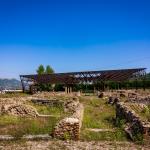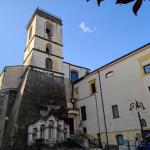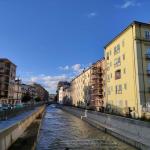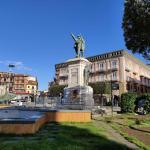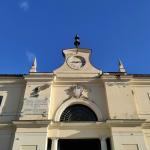The Municipality of Atripalda is located within the area of the Sabato Valley. It is a city of 10,805 inhabitants, located 294 metres above sea level and only 3 km from Avellino. The territory extends for 8.59 sq km and the adjoining municipalities are: Aiello del Sabato, Avellino, Cesinali, Manocalzati, San Potito Ultra, Santo Stefano del Sole and Sorbo Serpico.
The etymology of the name possibly derives from Troppualdo (or Truppoaldo), Lombard king, owner of some areas on the banks of the Sabato river who, around the year 1060, built a castle that bore his name. According to other sources, the name probably descends from trepalium, a place where criminals were executed: in support of this thesis, there are those who see in the symbol of the municipality (an arm bearing the flagellum) the memory of this origin. The inhabitants are called Atripaldesi and Saint Sabinus is their patron saint.
PLACES OF INTEREST
- Archaeological Area of Ancient Abellinum - Important archaeological site that includes the remains of the ancient Roman colony of Abellinum, from which today’s provincial capital of Irpinia originated
- Church of Sant’Ippolisto Martire (Saint Ippolisto the Martyr) - Church of the late-Early Christian era with a 19th-century appearance, known for its crypt, the Specus Martyrum, ancient early Christian cemetery of Abellinum
- Museum of the Palazzo della Dogana dei Grani (Palace of the Grain Toll House) - Located in Piazza Umberto I, it is a museum where the historical-artistic artefacts recovered after the earthquake of 1980 are exhibited
- Church of Santa Maria del Carmine (Saint Mary of Mount Carmel) - Church that stands out for the statue of the Virgin of 1739 and for the Coronation of Our Lady of Mount Carmel depicted on the ceiling
- Church of San Nicola da Tolentino (Saint Nicholas) - Consecrated church, also home to conferences, concerts and cultural events
- Former Convent of the Dominican Fathers (Civic Palace) - Restored in its ancient beauty as a municipal seat, thanks to a skilful restoration
- Church of Santa Maria delle Grazie (Holy Mary of Graces) - It was used by the Caracciolo family as an aristocratic chapel
- Former Monastery of Santa Maria della Purità (Saint Mary of Purity) - 17th-century conservatory established for functions of refuge and protection, it is now home to cultural events
- Monumental Complex of the Alcantarini - Also known as the Church and Convent of San Pasquale, it offers a reception service for groups of all ages
- Caracciolo Palace- Dating back to the 17th century, it has a beautiful upper loggia, open to the park and an important example of an Italian garden
- Green areas - San Gregorio Public Park, Villa Comunale “Piazza del Sole”, Acacia Park
- Other - Piazza Di Donato, Piazzetta degli Artisti, Bell tower of San Sabino Vescovo (Saint Sabinus Bishop)
EVENTS
- Focaroni di San Sabino - Bonfire in honour of the patron saint, held in February
- Giullarte - International festival of street theatre and ancient crafts, held in September
- The Places of Music - International Chamber Music Festival, held in the summer
- Atripalese Summer - Musical and theatrical event, held in the summer
- Atripaldese Christmas - Festival with musical and theatrical performances, held during the Christmas period
- Carnival in the Square - Masked parade through the streets of the city, takes place in February
- Feast of Saint Anthony - Celebrations in honour of Saint Anthony of Padua, held in June
- Feast of San Sabinus - Celebrations in honour of the patron saint that take place on 16 September
TYPICAL FOOD AND PRODUCTS
- Turnips and potatoes - Typical dish based on turnip greens, potatoes and chilli pepper
- Fiano di Avellino DOCG - One of the finest white wines of Italy and the international market
- Caciocavallo Silano PDO - Semi-hard cheese, with spun curd, produced with milk from different breeds of cows, including Podolica
FUN FACTS
The Roman colony of Abellinum, Latin name of Avellino, stood in the current municipal territory of Atripalda.
It was awarded the title of city by royal decree of 18 July 1867.
HISTORICAL NOTES
The origins of Atripalda are very ancient. According to tradition, Sabatio, Noah’s great-grandson, would have given life to the first human settlement located along the banks of the Sabato river, called Sabathia. To have, however, historical evidence about the existence of civilisations in the current Atripaldese municipal territory, we must wait for the Samnite era, during which Abellinum was founded.
In the 11th century, the Lombard king Troppualdo laid the foundations for the birth of today’s Atripalda which, with the succession of the various eras, became an important economic, cultural and artistic hub. It was later a fief of the Capece, Orsini and Caracciolo families: the latter family administered it for about two and a half centuries, until the abolition of feudalism in 1806.
Severely damaged by the earthquake of 23 November 1980, Atripalda has experienced, in recent years, a substantial demographic increase that has allowed its ancient commercial vocation to be reawakened.
Atripalda has a tangible past still alive with the Abellinum archaeological area and visiting it means establishing that connection with time, sharing a memory, a not to be missed experience
Atripalda
Piazza Municipio, 1, 83042 Atripalda AV, Italia
Events
-
From 26 June to 26 July 2023 in Atripalda, stories of resilience in the images of Aurelia…
Appointment Friday 17 January at the Circolo Fortapàsc
-
On 15 and 16 July 2023 two days for a big party in honor of the patroness Maria Santissima del…
-
On February 8th the traditional lighting of the bonfire returns in Piazza Umberto I. On Sunday…
-
From 22 July 2023 the International Chamber Music Festival in Irpinia returns with the XXXI…
On March 4th, at the Circolo Arci Fortapàsc, Shrove Tuesday is celebrated with music and…
Featured places
Via Piazza Tempio Maggiore, 1, 83042 Atripalda AV, Italia
A religious building from the late Paleochristian era with a 19th-century appearance, famous…
Piazza Umberto I, 83042 Atripalda AV, Italia
The museum where historical and artistic artefacts recovered after the 1980 earthquake are on…
Rampa San Pasquale ,Piazza Umberto I Atripalda
An important archaeological site that includes the remains of the ancient Roman colony of…
Did you like it? Leave a review
Your opinion is important! It will be visible after approval by the editorial staff.
To post a comment you must be an authenticated user. Log in with Social Login
